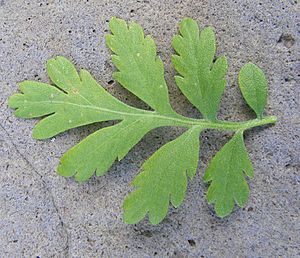Feverfew facts for kids
Quick facts for kids Feverfew |
|
|---|---|
 |
|
| Scientific classification | |
| Synonyms | |
Tanacetum parthenium, commonly known as feverfew, is a pretty flowering plant. It belongs to the daisy family, called Asteraceae. People sometimes grow it as an ornament in gardens. You might also hear it called Chrysanthemum parthenium or Pyrethrum parthenium.
Contents
What Does Feverfew Look Like?
Feverfew is a perennial herb, meaning it lives for more than two years. It grows into a small, bushy plant, reaching about 70 centimeters (28 inches) tall. Its leaves are light yellowish-green and have a strong smell. They are also deeply cut, almost like feathers.
The flowers look like small daisies. They are about 20 millimeters (0.8 inches) wide and grow in loose clusters. The outer petals are white, and the center is made of tiny yellow tube-shaped flowers. Feverfew spreads quickly by its seeds, so it can cover a large area in just a few years.
Where Does Feverfew Grow?
Feverfew originally comes from parts of Europe and Asia, like the Balkan Peninsula, Anatolia, and the Caucasus mountains. However, because people have grown it for so long, it has spread all over the world. You can now find it in the rest of Europe, North America, and Chile.
How to Grow Feverfew
This plant is a perennial herb, so it comes back year after year. It likes to grow in full sun. When planting, give each plant about 38 to 46 centimeters (15 to 18 inches) of space. In the autumn, you should cut the plant back close to the ground. It can grow up to 70 centimeters (28 inches) tall. Feverfew is quite tough and can survive cold temperatures down to about -30°C (-22°F).
Sometimes, outside of its natural home, feverfew can become an invasive weed. This means it can spread very easily and take over areas where other plants are trying to grow.
Uses of Feverfew
Feverfew in Traditional Medicine
For a long time, people have used feverfew in traditional medicine. They believed it could help with headaches. However, scientists have not yet found strong proof that it works for this purpose.
Feverfew contains a substance called parthenolide. Scientists are currently studying parthenolide to see if it has other useful properties, possibly even for serious illnesses. In some countries, like the Nordic countries, feverfew is approved as a traditional herbal medicine under the name Glitinum. In the European Union, only powdered feverfew is approved for use as a herbal medicine.
Feverfew as a Supplement
You can find feverfew in supplements. However, the amount of parthenolide in these supplements can be very different. Some might have a lot, and others very little, even if they claim to be "standardized."
Things to Know About Using Feverfew
If someone uses feverfew for a long time and then suddenly stops, they might experience what is called a "withdrawal syndrome." This can cause headaches to come back and make muscles and joints ache.
Feverfew can also cause allergic reactions for some people, including skin rashes. Other side effects might include an upset stomach, like nausea, vomiting, stomach pain, or gas. If the herb is chewed or taken by mouth, it can sometimes cause sores in the mouth, swelling, or numbness.
It is very important that pregnant women do not take feverfew. It can also affect how some medicines work, especially those that make your blood thinner, which could increase the risk of bleeding. It might also interact with other medicines that are processed by the liver.
History of Feverfew
The name "feverfew" comes from the Latin word febrifugia. This word means "fever reducer." Even though the name suggests it helps with fevers, it is not considered useful for that purpose today.
We don't know exactly when people first started using feverfew as a medicine. However, it was written about in the first century CE by a Greek doctor and herbalist named Pedanius Dioscorides. He described it as a plant that could help reduce swelling and pain.
See also
 In Spanish: Tanacetum parthenium para niños
In Spanish: Tanacetum parthenium para niños



